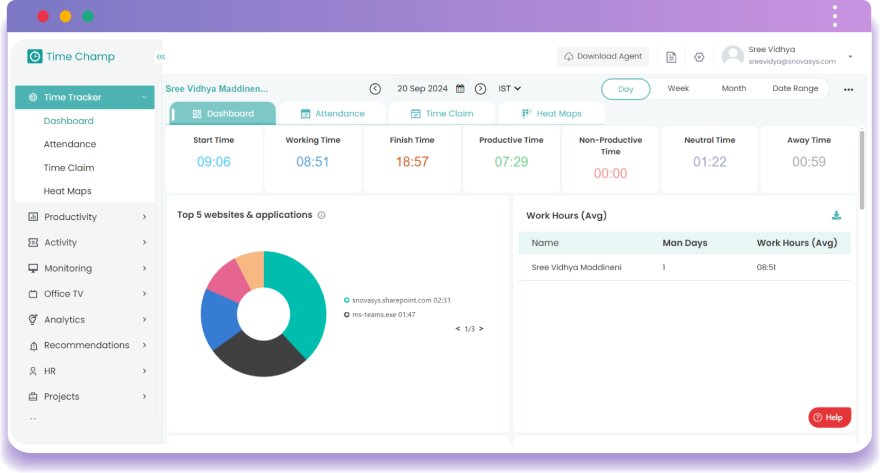Managing employee hours can sometimes be a mess if there is no proper structure to follow. A time tracking policy is a clear guideline that can be followed to minimize confusion and inconsistency in the number of hours recorded. In this blog, we explore why this policy is crucial, as it is the way to ensure proper documentation and accountability at the workplace.
What is a Time Tracking Policy?
A time tracking policy is a set of rules that an organization sets to regulate how employees document their working hours. It outlines the tools or systems used, how time is measured, and the processes for recording working hours, rest periods, and extra hours worked.
The policy helps to maintain the uniformity of time tracking, and it describes the expectations of the company and the obligations of the employees and managers in the process of timekeeping .
Why Establishing a Time Tracking Policy Is Crucial?
Establishing a time tracking policy is important to ensure that the organization maintains its efficiency and upholds standards. A report by the American Payroll Association shows that organizations that have well-defined time management policies have up to 25% fewer payroll mistakes. Here’s why having such a policy is vital:
Accurate Record Keeping
A clear policy helps in track the working hours accurately and reduces the chances of payroll mistakes. This accuracy is important in determining the right pay for the employees and in the financial statements. It also helps in the accurate estimation and budgeting of the project costs since detailed records of time help in understanding the costs of labor.
Accountability and Responsibility
By setting clear guidelines for time tracking, both employees and managers understand their roles and responsibilities. This clarity helps to ensure accountability since people understand what is required for recording and working hours. It also assists in appraising employee performance in terms of the time taken to complete the tasks or projects.
Compliance with Regulations
A formal policy helps ensure that the company complies with labor laws and other standards. It assists in avoiding legal issues such as wage issues and guarantees compliance with industry and contractual standards. When there is a clear policy in place, it becomes easier to remain compliant and this helps in minimizing problems.
Key Components of a Time Tracking Policy (Template Included)
Below are the key components that should be included to create a clear and effective policy that meets your organization’s needs.
Purpose of the Policy
This explains why the policy is being implemented. It justifies the importance of time tracking to have a correct calculation of the payroll, compliance with the legal requirements, and control over the productivity of the employees and the time of the projects or tasks.
Scope and Applicability
Determines the scope of the policy in the organization and who it covers. This may include or exclude all employees who are employed on a full-time basis, part-time basis, hourly basis, or on a contract basis, and it also notes whether any particular positions or departments are exempt or are subject to other rules.
Time Tracking Tools
Specifies the tools or systems that the employees are expected to use in recording their working hours, idle times, and any extra hours worked. This could include digital timesheet software, time tracking systems, or mobile applications that are specific to the organization.
Time Entry Guidelines
Details how employees should report their time, including when and how often they must log their hours, how to record breaks, and what procedures to follow for reporting overtime hours. This ensures uniformity across the company.
Roles and Responsibilities
Contributes to the identification of the roles of different stakeholders in the process of time tracking. Employees are responsible for entering the correct working hours, managers for reviewing the timesheets, and finally, HR/payroll uses the data for payroll and reporting.
Accuracy and Compliance
Emphasizes the importance of time recording and provides consequences for non-compliance with the rules, such as missed entries, faked data, or late submission. This section may contain consequences for failure to continue to abide by the provisions of the law.
Auditing, Exceptions, and Adjustment Procedures
Describes how time records will be checked, for example, by managers or HR from time to time to ensure compliance. It also describes how an employee can apply for an exception or change a time entry because of an error or other circumstances with the approval of a manager.
How to Create an Effective Time Tracking Policy
This section highlights key steps to create a policy that supports effective time tracking in your organization.
Step 1: Identify Your Business Needs
-
Assess the requirements of the business field based on the level of the project and legislation.
-
Talk to the department heads and other stakeholders to learn what they require and what they consider to be issues concerning the departments.
-
For instance, in the health care or construction industry, time tracking may include compliance laws or shift work.
Step 2: Choosing a Time-Tracking Method
-
Compare different time-tracking tools based on their features, ease of use, compatibility, and price.
-
Search for software that has features like automatic tracking, comprehensive reports, and compatibility with other systems.
-
Ensure the selected tool is effective for both office and remote workers and accommodates various working schedules including shift work.
-
Select a method that is suitable for the organization and can be implemented across the organization without compromising the employees’ accessibility.
Step 3: Draft the Policy
-
Use simple language in the policy to prevent any confusion and avoid jargon.
-
Documenting working hours, rest breaks, and overtime. How frequently it is updated, for instance, daily, or weekly?
-
Explain the methods that are allowed to be used in recording time and any other processes that may be needed.
-
Specify the consequences of noncompliance with the policy such as demotion or alteration of the employee’s compensation system.
Step 4: Get Legal and HR Approval
-
Discuss with the legal and human resource departments to ensure that the policy meets the legal requirements of the country of operation such as FLSA in the United States or other similar laws in other countries.
-
Ensure that the policy is in harmony with the organizational culture and does not infringe on the employees’ liberties.
-
Make sure that the policy touches on legal aspects, like overtime, meal periods, and record keeping.
Navigating Challenges in Time Tracking Policy Implementation
Establishing a time tracking policy might appear simple at first, but it can come with a few bumps along the road. Here are the challenges that can surface during the process:
Employee Resistance and Pushback
Some of the employees may consider time tracking as an invasion of their privacy or as a lack of trust in their employers. They may feel that they are being controlled too much or that their freedom to work is being limited, which results in demotivation and dissatisfaction.
Solution: To counter this, communicate and explain the need to track time effectively. Stress how it is advantageous for the company and the employees as it promotes equal distribution of work, clarity of workload, and career development. Provide sessions to demonstrate how it can help in time management and work-life balance. Engage the employees in the process by seeking their input to develop a policy that is more friendly to the employees.
Technical Issues and Integration Problems
One of the main challenges that is associated with the use of technology when putting in place a time-tracking system. Implementation can be slowed down by system bugs, incompatibility with other business tools, or inability to access the system remotely.
Solution: Select a system that can easily connect with other systems you are using, for instance, payroll or project management systems, and the system should be compatible with remote working environments. It is advisable to test it first before implementing it in the entire company. Furthermore, have IT support available to fix any technical problems as soon as possible and make sure that the employees know how to solve simple problems.
Complexity in Policy Implementation
The process of introducing a policy in an organization is not an easy one. The employees may have different roles, working hours, or working places, which makes it even more challenging. Failure to ensure that the policy is implemented similarly across the various teams or departments may lead to confusion and compliance issues.
Solution: Make sure that the policy can be flexible depending on the workplace while at the same time providing certain standards. Having a single system for tracking time at all locations and in all positions can help eliminate confusion and increase compliance. Managers should make sure that employees adhere to the policy and conduct check-ins from time to time to ensure that the policy is being implemented as required.
Legal and Compliance Issues
Policies on time tracking must respect the local laws, especially on overtime, breaks, and employee rights. Noncompliance with these regulations poses legal risks and possible penalties to the organization.
Solution: Review regularly to check whether it complies with the current labor laws. Make sure that the tracking system complies with the legal requirements and records work hours while notifying you about overtime or missed breaks. Seeking advice from legal advisors and staying updated with the new laws will assist the organization avoid compliance risks.
Best Practices for Enforcing a Time Tracking Policy
Notably, it is estimated that organizations can waste up to 7% of their payroll costs through ineffective time management. To prevent such mistakes, establish the right time tracking policy in the organization. Now, let’s look at the measures to ensure that your policy is both effective and accurate.
Keep the Policy Simple
The policy should be clear and simple to follow. Do not complicate it with too many rules or requirements that are hard to follow. Make the tracking process as easy as possible so that employees will follow it and not get confused.
Focus on Outcomes, Not Just Hours
When adopting a time-tracking policy, avoid creating a culture that will make the employees more concerned with the number of hours they have worked. Emphasize that the goal is to maximize work and productivity, not the time spent on it.
Protect Employee Privacy
Make sure that your time tracking policy does not infringe on the employees’ rights to privacy. It is important to know what data is being collected and for what purpose it is going to be used. Reassure the employees that the information will not be used to monitor their work but to enhance productivity.
Regularly Review and Adjust the Policy
Ensure that you are always checking the efficiency of the time tracking policy that you have put in place and make changes where necessary. If some of the aspects of the policy lead to the formation of bottlenecks or dissatisfaction, do not be rigid and be ready to change the process.
Also Read: Break Time Policy Essentials: Key Points to Understand
Integrating Time Tracking Policy with Time Champ

Establishing a time-tracking policy is crucial for organizations that seek to improve the efficiency of their employees and enforce accountability. But having a good policy in place is just the first step. To implement and manage it effectively, you need the right tool.
This is where Time Champ comes in. Being a powerful employee monitoring and time tracking software, Time Champ helps you to implement your time tracking policy effectively. It has features such as real-time activity tracking, comprehensive reporting, and integrated timesheets, so your policy is not only written down but is also implemented in how time is spent in your team.
With Time Champ, you can easily track employee hours, timesheet management, and analyze data while ensuring full compliance with your time-tracking policy. It transforms your policy from a set of guidelines into a functioning system, ensuring smooth operations, enhancing team efficiency, and making it easier to monitor and improve performance.
By bridging policy with practice,
Time Champ helps you transform your
time-tracking guidelines into real,
tangible outcomes that enhance your
business
performance.
Also
Read: Free
Employee Attendance Policy
Template
Conclusion
The successful establishment of a time tracking policy provides a framework that is beneficial for businesses and employees. Thus, flexibility and trust can be seen as the key factors that can enhance organizational efficiency while preserving the employees’ morale.
Frequently Asked Questions
Helps the employer to track the time taken by the employees especially those working from home to ensure that they complete the tasks within the required time. It assists in keeping track of the time and gives an understanding of how it is being spent, which can be useful for managing the work and productivity of remote employees.
The time-tracking policies are beneficial for industries with high labor costs, project-based work, and flexible working hours such as construction, healthcare, IT, and consulting. These industries rely on time logs to calculate costs, bill their clients, and adhere to the law.
Lack of time tracking policy leads to payroll discrepancies, legal noncompliance, and low efficiency in business operations. The absence of structure results in the irregularity of the reports and thus the inability to monitor the costs of the project or the performance of the employees.
A time-tracking policy should be revised at least once a year or whenever there is a change in the regulations, technology, or company processes. This way, it is possible to make sure that the policy remains relevant and useful for the organization’s needs.



